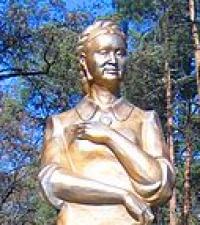Вы здесь
Monument of Baiseitova in Almaty.

Monuments to opera singers in Kazakhstan.
“...the amazing appearance of this singer made a tremendous impression on me... I could not name the singer with whom I could compare her - the high, light and transparent voice of the Kazakh singer is so individual and original ... Kulyash Baiseitova is a true pride not only Kazakh, but also all of our Soviet art"
Opera singer V.V. Barsova.
A trip from Irgiz to Almaty.
Monument to the opera singer Kulyash Baiseitova installed in the park at the music school. Kulyash Baiseitova on Bayzakova street, below Timiryazev street on September 15, 2011 on the eve of the singer’s 100th anniversary. The author is the sculptor T. Binashev.
Kulyash Zhasynovna Bayseitova (name at birth - Gulbakhram; Kaz. Kүlәsh Zhasyngyzy Baiseyitova; 1912 - 1957) - Soviet Kazakh opera singer (lyrical and colororan soprano), dramatic actress. Laureate of two Stalin Prizes of the second degree (1948, 1949).
The youngest owner of the title “People's Artist of the USSR” (1936) for all the years of his assignment. Kulyash Baiseitova (Beisov’s maiden name) was born on April 19 (May 2) 1912 (according to other sources - January 12) in the city of Verny of the Russian Empire; according to other sources, she was born in the steppes of Sary-Arka in one of the villages (Zhanaortalyk) of the Karkaraly district of Semipalatinsk region.
Kulash was brought to Alma-Ata at the age of twelve, and for some time she lived in a boarding school. Baiseitova’s natural musical talent manifested itself early. She memorized and performed songs, zhyr and kissa, heard from father Zhasyn.
In 1925 - 1928 she studied at the Almaty Pedagogical College of the Institute of Education, participated in amateur music. In 1930, she entered the studio of the Kazakh Drama Theater, established today in 1926 in Kyzyl Orda and in 1929 transferred to Alma-Ata, known as the Kazakh State Academic Drama Theater named after M.O. Auezov.
Studying acting and musical literacy, he plays small episodic roles in the theater, and soon the main ones. In 1933, Kulyash joined the troupe of the Musical Theater (now the State Academic Opera and Ballet Theater named after Abay), where she performed until the end of her life.
She was engaged in singing in the training studio of the theater with K. A. Dianti and V. A. Smyslovskaya. “.. When we listened to the part of Cio-Cio-san performed by Kulyash, our knowledge of the Kazakh language did not bother us at all.
It seemed that we understand not only the general idea expressed by the artist, but also every word she uttered. The state of Chio-Cio-san was so clearly expressed in the facial expressions and intonations of the artist...
”From the manuscript of the director A. Troitsky“ Legacy of Kulash Baiseitova”. Baiseitova’s musical and stage talent was clearly manifested in creating the image of Ayman in the musical comedy “Ayman - Sholpan” on the libretto by M. O. Auezov, music by I. V. Kotsik.
The image of Shuga (musical drama “Suga” by B. Maylin and I. Kotsik) testified to the singer’s increased skill, the Zhibek part (“Kyz-Zhibek” by E. G. Brusilovsky) allowed the singer to rise to the heights of classical opera.
She also performed as a concert singer. She performed folk songs in many languages (Kazakh "Eligay", "Shili Ozen", Russian "Bell", Polish "The girl went," Czech "Shepherd", Armenian "Swallow", etc.), works of Russian, Soviet and Western European composers.
During the war, Baiseitova went to the front as part of a concert team. In 1944, she starred in the musical film “Concert of the Five Republics”. Since 1949 - member of the Soviet Peace Committee. She was the organizer and permanent leader of the Kazakh Theater Society. Participated in the work of the II World Congress of Peace Supporters.
Member of the CPSU (b) since 1943. Member of the Supreme Council of the Kazakh SSR 1st - 3rd convocations. In June 1957, Baiseitova went to a concert in Moscow. After the concert, complaining of pain in her head, the singer returned to the hotel.
On the morning of June 6, the maid found her lifeless body in the bathroom. Doctors later found a brain hemorrhage. She was buried in Alma-Ata at the Central Cemetery.
Authority:
Brief Encyclopedia of the Kazakh SSR, Volume 4, Culture, Alma-Ata, 1990. Vikipedia.







